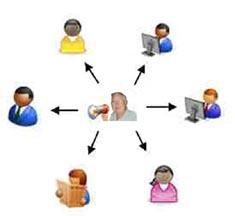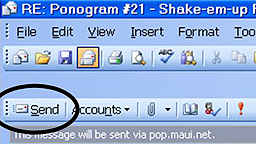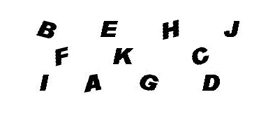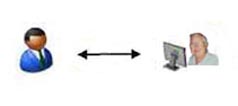THE USE OF E-MAIL
A while ago one of you (Person A) noted that many Pono e-mails say that I look forward to hearing from “you”, and yet the e-mail is obviously sent to a list of addresses on blind copy. Person A then wondered if I really wanted to hear from him/her, or if the request was only directed to certain “yous” on my distribution list, or if I was just being polite.
The comment got me to thinking about e-mail and the way I use it, the way I wish it would work, and whether what I’m doing is fair to all or self-centered. I responded to Person A with a subset of what you are reading here, but I went on thinking about it and it turned into this Ponogram. (BTW, Person B wanted me to take him/her off the list for Ponograms because s/he couldn’t afford to buy a Ponograph.)
What kind of e-mails do I send out?
I send a number of broadcasts addressed to most of the people in my address book. These include Ponograms; health, travel and other announcements; Christmas and other greetings; your occasional request for information; and rarely – what I consider an exceptional forward.
I conduct dialogs about genealogy, family issues, and any number of other areas of interest. Most of these are one-on-one, but others involve relatively small distribution lists consisting of subsets of the address book.
 |
Left – One to many – Broadcast |
What kind of e-mails do I receive?
Spam is, of course, ubiquitous. One of my e-mail servers labels spam quite effectively and I simply direct it without review to the ethereal realm with a rule. The other e-mail server recognizes most spam and doesn’t transmit it to me – I then review it on their server and delete weekly or so. Some spam that sneaks through these filters is consistent enough so I build rules to can it. Still, a few get to my general inbox each day and are deleted without further ado.
I subscribe to a few genealogy lists and get many e-mails from them. I scan them all (even the ones written in Swedish) looking for people and places of interest to me. I save a few of them if I find the information to be potentially valuable to my research. I respond to those few queries and comments that fall within my area of “expertise” or pertain to subjects I have personally researched. Sometimes these responses lead to productive dialogs!
Messages from all of you on my active list are directed to a special folder via a rule, so I’m unlikely to miss your e-mails and I give special attention to all in this folder. I depend on you to keep me advised of changes in address so I can change the rule accordingly. I lose people sometimes when they don’t let me know of changes and I can only guess that it was an “oversight” on their behalf. I know of the loss when I try to send a Ponogram or whatever and demons tell me that address does not exist.
So, what do I get from you and how do I respond?
By far the most prevalent e-mails I receive are forwards – usually sent to me as a member of a large list of people – which of course means no personal message is included. I suppose I look at about 80% of these. Of the other 20%, there are *many* duplicates that get deleted, a number that have no subject line and get “closer examination”, a number that have suspicious “click on” areas that raise my paranoia, many that threaten me with hellfire and damnation if I don’t follow the directions precisely, etc. The majority of this 20% rest in peace. Sorry, there are just toooo many to take chances.
Of the 80% of forwards I look at, I think you will notice that I send a brief response if I got a good chuckle, a burst of interest, a warm feeling, or some other atypical (for me) human emotion. The rare *outstanding* forward is forwarded from me back to all of you. If you get one back you know that it passed the Pono filter and was found to be of great redeeming social value. (Think “Battle at Kruger” and “Elephant that Paints”.)
The next most prevalent e-mails I receive are the replies to things I have sent you. This is a category that I really look forward to and love to get. Replies are really easy to do. For those of you who don’t know how, follow this instructional. Open the e-mail from me. In the upper left of your screen, find the “Reply” button (see the helpful illustrations below), touch it, type in “Hi Pono! We are all fair to rotten! Take care!”, sign your name and hit “Send”! Try it, you’ll like it!
 |
 |
I reply to your replies based on what I get. If I get “enjoyed the Ponogram” or “glad you’re feeling better”, I don’t perceive the need for more. If I get a “what kind of tree is that?” or “was the surgery laparoscopic?”, I answer the question with thanks for the interest. If I get “I remember that incident, but don’t remember who else was there” and “we are hoping to see you this summer either here or there”, obviously this is the start of a dialog and I pick up on it.
Unfortunately the category with the greatest interest to me and the least number is the personal message initiated by you. I treasure these and hope that my responses to them display that feeling. I really thought that the advent of e-mail would increase the quantity of letters going back and forth between friends and relatives, but alas, people who didn’t write notes, cards or letters also do not write e-mails. Person C, this describes you!
Now, how did I get all these people in my address book?
The most obvious category is relatives. Many of my older relatives have resisted connectivity, but the younger ones tend to have e-mail.
It took a while, but I actually have contact with a couple of classmates from high school.
It took even longer, but I now have contact with an Army buddy and some old friends from Germany, where I was stationed for a couple of years.
Not surprisingly, the majority of my contacts came from my computer software engineering career. Our commonality dates back to 63-71 at System Development Corporation in California and Bangkok, 71-91 at Abacus Programming Corporation in CA, and 91-98 at Rockwell/Boeing in CA and then HI. Other contacts date from these periods and places but are not necessarily related to my work.
In HI from 96-04 I did a lot of golfing. For a big part of that time I organized a group, making the contacts, getting commitments, and setting up the reservations. Although I quit golf when I had the surgery in 04, I picked up some golf buddies that way who are still in my book.
When I retired in 98, I jumped into genealogy seriously and have made many contacts in the US and Sweden who are now in my address book. Some of these are actual relatives and others are valued friends and information resources. An interesting sub-category is “Sandins who are not related to me”. When I hear from a Sandin or descendent of a Sandin, I try to determine if there is a relationship by tracing back to the person who adopted the name. By the time I find that key information, I have often developed a friendship that continues!
I think you’ll find that some of you fall into more than one of the above categories – I’ll try not to send you duplicates of my all-hands broadcasts!
Here’s a little exercise for you – can you find yourself in this list?
Person D sends me an average of about 4 e-mails per day. The e-mails cover the entire range from personally taken pictures, to forwards of all kinds, to personal messages, to responses to my e-mails. If I don’t hear from D on a given day, I get a bit anxious.
Person E sends lots of forwards, but also responses to my e-mails and personal messages. When I “process” old e-mails, I first separate out all from E into a separate folder and then save most of the attachment files s/he forwards.

Person F is pretty regular and apparently checks his/her e-mail a couple times a week and almost invariably responds to my messages in some way. F never sends forwards but often sends personal pictures and although never verbose, always has a personal message.
Person G is nearly always the first to respond to my broadcasts. I suspect that G’s computer monitors for and announces the arrival of e-mails and when G is home s/he reads e-mails as they arrive.
Persons H(1) through H(lots) never respond to anything. The only reason I keep sending is that I do not get a failure notice to my messages. For all I know you folks have a rule directing my missives to cyberspace, but I don’t care. I just keep hoping you get a chuckle or a guffaw or at least a titter from the stuff I send – or at the very, very least are not offended by it!
Persons J(1) through J(number) are inspired once or twice a year to respond to something and I am always grateful!
The rest of you are Ks. Your e-mail habits are spasmodic and extremely human. I always hope to provoke a response and sometimes succeed and sometimes fail. Sometimes we even conduct a dialog for a few days!
The entire alphabet is valuable to me! I wish I could get more personal messages and pictures – would it help to beg? I wish I could receive a brief note once a month or even once a quarter. I wish you would send personal status broadcasts to your address book (and I hope I’m in it).
On the other hand, I hope I’m treating you fairly. I hope I answer your queries – either personally or in broadcasts. I hope I don’t overdo communications. I hope I respond in a way that makes you want to keep communicating. I hope you are still reading this sentence.
Thanks for being there!
Important disclaimers!
The fact that colorful little dummies were used in the diagrams herein should not be interpreted to reflect on the attributes of any actual persons, living or dead, who might be entered in my address book.
This Ponogram was made on equipment that also processes peanuts, nuts, and wheat.
 |
 |
 |
| Peanuts | Mixed Nuts | Wheat |
[Visitor number
]
